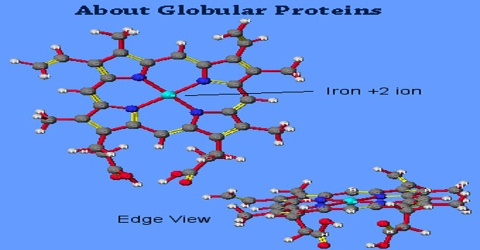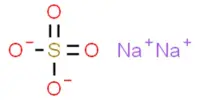About Globular Proteins
Globular proteins are somewhat water-soluble (forming colloids in water), unlike the fibrous or membrane proteins. In a globular protein, the amino acid chain twists and folds in a manner that enhances the protein’s solubility in water by placing polar groups of atoms at the protein’s surface, where they can participate in attractive interactions with water molecules.

Some of the common amino acids have polar side chains; this polarity is the result of chemical bonds between atoms in these side chains that have very different electro negativities for instance, oxygen and hydrogen. A protein’s polar side chains tend to exert strong attractive forces toward other polar groups of atoms within the protein molecule, or toward polar molecules in the protein’s surroundings. Similarly, nonpolar side chains exert attractive forces of a different nature toward other non-polar side chains within the protein. The shape assumed by a globular protein molecule tends to maximize both types of attractive forces, whereby nonpolar side chains “point” inward and interact with one another and polar side chains are oriented outward such that they are exposed to adjacent polar water molecules. Over the last few decades, molecular shape and structure have been experimentally determined for several thousand proteins.
There are multiple fold classes of globular proteins, since there are many different architectures that can fold into a roughly spherical shape.
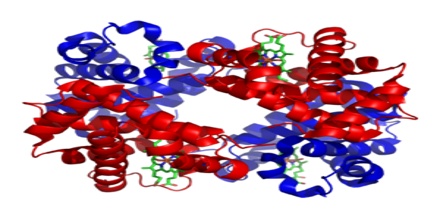
Globular proteins also function as anti-bodies in the body’s immune system and as transport vehicles for other molecules in circulating blood, and they are heavily involved in the replication and repair of DNA.
Most proteins which occur in the aqueous, intracellular environment or in the plasma are of globular nature: they are very approximately spherical in shape, or consist of several different lobes (domains). Generally, proteins with more than about 200 amino acid residues are multi-domain. The different domains of a single protein may be responsible for quite different functions.
Proteins are Linked-Together Amino Acids
Unlike human-sized machines, which are often built from a bewildering variety of different parts, globular proteins are put together from one class of components, called amino acids. There are 20 different types of amino acids. A protein consists of a unique combination of amino acids drawn from this 20-member library. The amino acids that make up a protein are linked together into long linear chains, like a train made up of lots of individual box cars connected together, one after another.
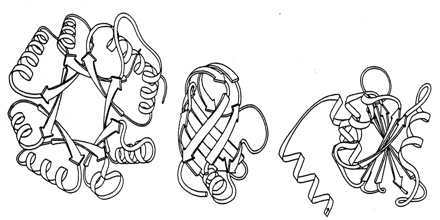
The reason amino acids can be linked together into long linear chains is because the right side of any one amino acid is strongly attracted to the left side of any other amino acid. When two amino acids stick together in this way, chemists say that a peptide bond has formed.
Structures of Globular Proteins
As in all proteins, the primary structure of globular proteins consists of a polypeptide, or chain of amino acids joined via peptide bonds. Hydrogen bonds between carboxyl and amine groups of the amino acids contribute to the secondary structure, which in globular proteins may include alpha-helices, beta-sheets, or both. Globular proteins are folded such that their tertiary structure consists of the polar, or hydrophilic, amino acids arranged on the outside and the nonpolar, or hydrophobic, amino acids on the inside of the three-dimensional shape. This arrangement is responsible for the solubility of globular proteins in water.
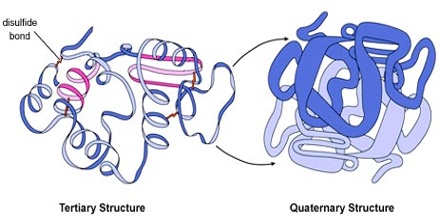
Globular proteins seem to have two mechanisms for protein folding, either the diffusion-collision model or nucleation condensation model, although recent findings have shown globular proteins, such as PTP-BL PDZ2, that fold with characteristic features of both models. These new findings have shown that the transition states of proteins may affect the way they fold. The folding of globular proteins has also recently been connected to treatment of diseases, and anti-cancer ligands have been developed which bind to the folded but not the natural protein. These studies have shown that the folding of globular proteins affects its function.
Some globular proteins, such as hemoglobin, also exhibit quaternary structure, in which multiple polypeptide chains are clustered together to form a functional protein. The shape of globular proteins is critical to their function. Those acting as enzymes, for example, must be folded such that their active sites are in the correct orientation and conformation to interact with their substrates.
Changes in environmental conditions, such as pH or temperature, may affect the bonds that contribute to the shape of globular proteins. These changes can lead to denaturation in which the shape of the protein is so altered that it is no longer functional. In the case of your eggs at breakfast, the heat used in cooking the eggs denatures the ovalbumin and other proteins in the egg whites, causing them to unfold and clump together into a yummy conglomeration of goodness.
Diseases are Caused by Errors in Protein Structure
A plane can’t fly unless all its parts are put together in the right way. The same is true for proteins. So true, in fact, that anyone can think of many diseases as errors of protein structure: something happens in the body that causes a protein to lose an aspect of its native conformation, and this loss of structure causes a loss of function.

The example of changes in protein structure that lead to disease happens in something called fatal familial sleeping sickness. The main symptom of this disease, as the name suggests, is permanent, incurable, and ultimately deadly insomnia. Like sickle cell anemia, the cause is a mutation that leads to a malformation of a protein, called major prion protein.
